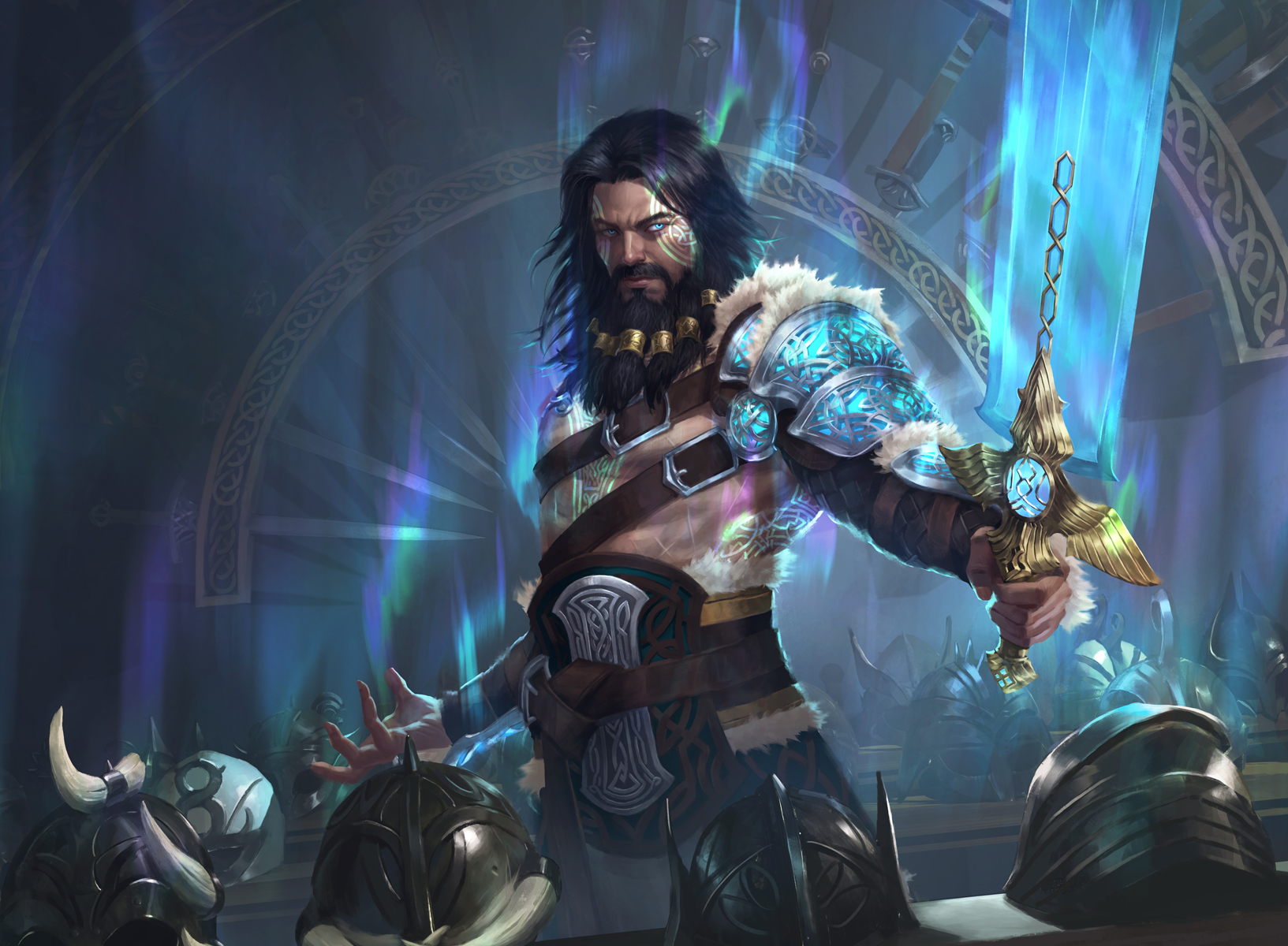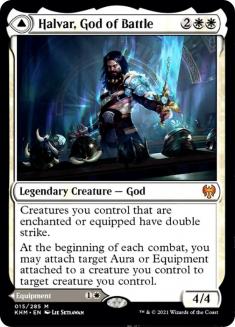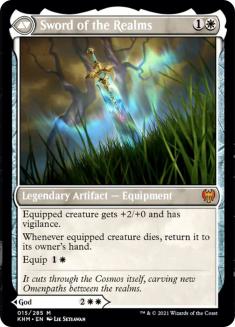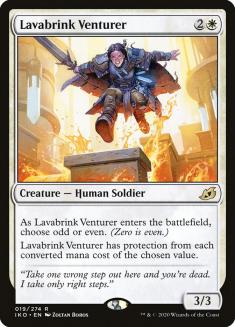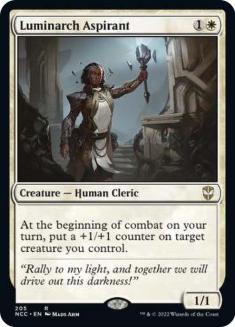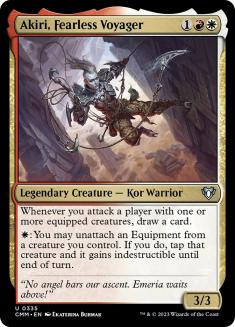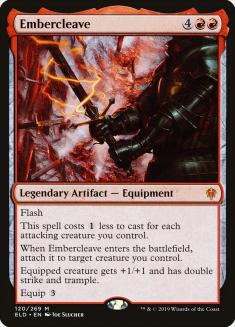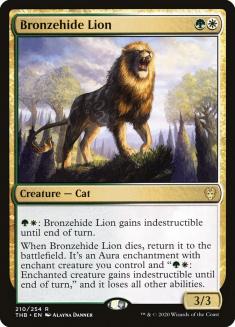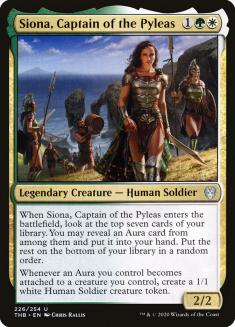I’ve always liked aggressive decks that have the ability to play a long game. That can be tough when you need to play lower-cost cards to create an effective curve, since you’re typically operating with cards of a lower power level than most of your opponents. The key has always been to have cheap cards that operate as mana sinks. That way, if your opponent stymies your first or second wave, you can reload by using your mana via those sinks rather than petering out.
Aggro decks that are successful in playing a long game don’t have to mulligan as aggressively, since it’s not a death sentence if your opening few turns aren’t flawless, and they often get the luxury of playing higher land counts without flooding as often, thus increasing their consistency. When you’re often winning in the first five or six turns, you don’t have time to cast cantrips or utilize Temples to smooth out your draw, so getting additional consistency baked into your deck construction is a significant advantage.
So when Maul of the Skyclaves was previewed a few months ago, I was naturally attracted to the powerful Equipment. It could serve as part of a powerful curve, especially in conjunction with Seasoned Hallowblade, and later in the game turned your otherwise weak creatures into formidable threats. I wrote an article extolling the card and exploring its potential uses in Standard.
Thus far, it hasn’t lived up to my expectations. It sees play in Mono-White Aggro, a fringe archetype in Standard most often seen on the Best-of-One ladder on Arena, though it has found a home as part of Stoneforge Mystic packages in Modern. Its success in such a powerful format is a good sign for its potential in the future, but the card needs some help if it’s going to break Lovestruck Beast’s stranglehold on creature decks in Standard.
And since this is the season of giving, Wizards of the Coast (WotC) saw to it to send that help in the form of Halvar, God of Battle.
As another DFC, there’s a lot to process here. First let’s consider the two halves separately.
On the front side, you have a reasonably efficient body that provides a clear build-around for Equipment and Auras. Double strike is a potent ability, and as a four-drop this curves nicely with Maul of the Skyclaves, allowing you to get immediate damage from Halvar. That’ll end games in a hurry when your draw comes together.
But the second ability is the real prize, since it generates free mana. I’ll admit that when I first read the card, I thought it could target unattached Equipment, which would’ve been ideal, since that’s a much higher-value activation than switching which creature is attached. But being able to manipulate your Equipment each turn still makes blocking difficult, especially when the newly equipped creature gains double strike to boot. The end-game for aggro decks often involves finding some way to break through for the final points of damage, and this ability certainly aids in that endeavor.
On the back side, you have a piece of Equipment which is okay on rate, but the triggered ability offers some protection to your creatures, which further bolsters your ability to play into the late-game against heavy disruption. I particularly like vigilance as the ability here because it means that in creature mirrors, your opponent likely can’t opt to race. If you want to block and win the game through attrition, you’ll have the opportunity to do so. It’s important to be able to dictate the texture of the game, and Sword of the Realms lets you do that.
Neither half of Halvar is overly impressive, merely solid. Either could be a role-player in the shell but wouldn’t be strong enough to carry an archetype. But what I like most about this card is how well they play together as the two sides of a DFC. One of the main problems with playing lots of Equipment is the high diminishing returns. These diminishing returns occur for two reasons.
First, Equipment are mostly useless without a creature to equip. If you draw one or two creatures and multiple Equipment, one or two removal spells can then generate multiple extra cards of virtual card advantage. It’s important to draw the two halves in an appropriate proportion, and as an aggro deck with little card selection, that’s not always going to be the case. Thus, building around Equipment synergies, while offering additional consistency by being a mana sink, also brings inconsistency by having more moving parts in your engine.
Second, even if you have the creatures to equip, oftentimes you don’t have the mana. Equipment are rather mana-intensive, and you only have so many lands to go around. If you have two or three Equipment on the battlefield, one or two of them is likely to go unused for several turns, and thus not be particularly valuable.
A card that represents either a creature or an Equipment goes a long way towards finding the delicate balance necessary to maximize your deck’s consistency in the early-game and power going long. The two halves cover each other’s weaknesses, which makes the card as a whole significantly better. When you need a threat it’ll be a threat, and when you need an Equipment, it’ll be that too.
Being two-sided also mitigates the downside of being legendary, since you can cast the other half if one of them is already on the battlefield. It’s rare that drawing Halvar will be bad, so you have a high-floor card whose synergies, when properly developed, also give it a high ceiling. That’s a recipe for success.
Building Around Halvar
Drawing upon the unsuccessful lists I brewed in the fall, my updated lists are stressing removal. The Equipment synergies themselves aren’t powerful enough on their own, so you need to interact. Normally, trying to fit sufficient numbers of creatures, Equipment, and removal spells in a 60-card list would be impossible, but there are many options for removal effects attached to creatures in the current Standard. You just have to abandon any potential tribal synergies with Warriors or the party mechanic and simply play the best creatures at each spot on the curve.
My other point of emphasis is the ability to go tall, to build one giant threat and protect it when possible, a la Azorius Auras in Historic or Selesnya Hexproof in Modern. These lists won’t be solely focused on that plan, but I want the ability to execute that at a high level. That means incorporating ways of protecting your creatures, which current Standard also has many options for.
In the interest of consistency, I started with a Mono-White variant:
Creatures (32)
- 4 Giant Killer
- 4 Alseid of Life's Bounty
- 4 Lavabrink Venturer
- 4 Seasoned Hallowblade
- 4 Selfless Savior
- 4 Skyclave Apparition
- 4 Luminarch Aspirant
- 4 Halvar, God of Battle
Lands (20)
Spells (8)

Despite being a Mono-White Aggro deck, this list has ten cards in the maindeck that can remove creatures or planeswalkers, and Giant Killer offers additional control of the battlefield once cast. That’s a total that rivals midrange decks, and yet the curve here is still quite low.
On the protection front, the eight one-drops stand out, but you also have Seasoned Hallowblade and Lavabrink Venturer which have built-in protection. Venturer can be awkward since naming odd prevents it from being equipped with Maul of the Skyclaves, while naming even stops Luminarch Aspirant and Sword of the Realms, but I don’t see that coming up too often and the value of a difficult-to-answer creature in a deck with so many pump effects is massive.
Luminarch Aspirant is sort of an honorary Equipment here, offering another avenue to build a game-dominating threat while also being a powerful card in its own right, especially with the number of one-drops this deck has.
Ultimately, the impressive part of this deck is that it fits 34 threats, eight Equipment, ten removal spells, and 22 lands into a 60-card list. Split cards enable you to build tight decklists with fully developed synergies without sacrificing the bread-and-butter elements of competitive Magic decklists, and I suspect we’ll only see spaces like these explored more as Standard grows in size.
Still, if you’re looking for a bit more power, you could go for a Boros list:
Creatures (29)
- 4 Giant Killer
- 4 Bonecrusher Giant
- 4 Seasoned Hallowblade
- 3 Skyclave Apparition
- 4 Luminarch Aspirant
- 2 Akiri, Fearless Voyager
- 4 Fireblade Charger
- 4 Halvar, God of Battle
Lands (20)
Spells (11)

This version plays 30 threats, ten Equipment, a whopping fifteen removal spells, and 25 lands. The mana consistency takes a hit, but the power level is there to pay you off, especially gaining a format pillar in Embercleave.
With more removal, more card advantage, and a higher power level, this list is less concerned with the all-in plan so there’s far less in the way of protection. Akiri, Fearless Voyager can sometimes step in, but you’re mostly casting it to draw cards. If this deck wants to end games quickly, it’ll rely on its unwavering faith in Embercleave.
The most surprising card here is likely Fireblade Charger, which mostly sees play as an option for Mono-Red decks to supplement their Fervent Champions. But here it works quite well. It’s a good creature to move an Equipment onto with Halvar since it’ll gain haste, and it also carries Sword of the Realms quite well since you can more easily force a trade and not only return it to your hand but take out an opposing creature as well. You’re looking to utilize the dies trigger, since it plays well with any pump effect, from Equipment to Luminarch Aspirant.
Both of these Equipment-focused lists are prepared to play games where their synergies don’t come online, and can win with a strong curve or by coming out on top in a series of exchanges. With Halvar offering both added power and consistency, I’m excited about the future of these kinds of decks in Kaldheim Standard.
For my last list, I went in another direction, focusing instead on Auras. That means further emphasizing the going-tall aspect at the cost of interaction. Typically we’ve seen these decks in Standard built as Orzhov, but I opted for green as the secondary color:
Creatures (25)
- 3 Siona, Captain of the Pyleas
- 4 Alseid of Life's Bounty
- 2 Bronzehide Lion
- 4 Seasoned Hallowblade
- 4 Selfless Savior
- 4 Luminarch Aspirant
- 4 Halvar, God of Battle
Lands (22)
Spells (13)

The main draw to green is Setessan Training. The card doesn’t jump off the page, but when you’re building a big creature, evasion is important, even more so when that creature will likely have double strike. Setessan Training and Halvar is a build-your-own Embercleave, and ours draws a card! I value evasion enough that I’ve also included a single copy of Maul of the Skyclaves.
Beyond Setessan Training are two role-playing creatures in Bronzehide Lion and Siona, Captain of the Pyleas. Lion is an efficient body that happens to create additional protection and another Aura in a deck that’s a bit short on them, since the options in Standard right now are slim.
Siona does the same by digging for one of your actual Auras, and with twelve hits you’ll find one about 80% of the time. But the second ability is most interesting here, since Halvar can reattach one of your Auras each turn, churning out 1/1 tokens to ensure that you’ll always have a body to pump. I could see adding a Makindi Stampede or two to try to take advantage of an unanswered token swarm, but for now I’d prefer a smoother manabase, especially with only 22 lands.
Gruul Adventures has been the dominant aggro deck in Standard for months now, and it’s not particularly surprising when you consider that Standard is at its smallest and that deck draws its synergies from the most powerful set available, Throne of Eldraine. But as new cards are added to the format and other synergies become better-supported, I suspect Gruul’s status will wane.
Personally, I’ve long been a fan of white cards in Standard, with powerful threats like Seasoned Hallowblade and Luminarch Aspirant. Maul of the Skyclaves wasn’t enough to push them into the top tiers of the metagame, but Halvar, God of Battle pushes them even closer, and there’s plenty more of Kaldheim left to reveal.
Basic Plains will have its day.

